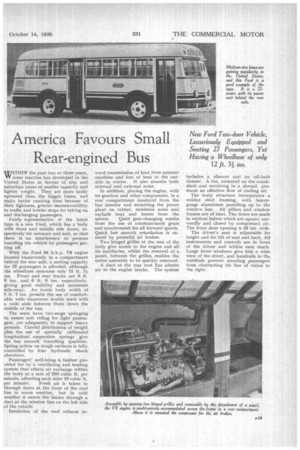America Favours Small Rear-engined Bus
Page 21

If you've noticed an error in this article please click here to report it so we can fix it.
New Ford Two-door Vehicle, Luxuriously Equipped and Seating 27 Passengers, Yet Haying a Wheelbase of only 12 ft. 31 ins.
WITHIN the past two or three years. YV some reaction has developed in the -United States in favour of city and suburban bused of smaller capacity and lighter weight. They are more easily operated than the bigger bases, and make better running time because of their lightness, greater raa.noeuvrability in traffic and briefer stops for taking on and discharging passengers.
Fairly representative of the latest type is a new Ford, which has a body with front and middle side doors, respectively for entrance and exit, so that there is no interference to persons boarding the vehicle by passengers getting off.
With the Ford 95 b.h.p. V8 engine located transversely in a compartment behind the rear axle, a seating capacity for 27 passengers is afforded, although the wheelbase measures only 12 ft. ins, Front and rear tracks are 6 ft 9 ins. and 6 ft, 6 ins, respectively, giving goed stability and minimum side-sway. An inside body width of 7 ft. 7 ins, permits the use of comfortably wide transverse double seats with a wide aisle between them down the middle of the bus_
The seats have two-stage springing to assure soft riding for light passengers, yet adequately to support heavy persons. Careful distribution of weight plus the use of specially calibrated longitudinal suspension springs give the bus smooth travelling qualities. Spring action on rough surfaces is fully controlled by four hydraulic shock absorbers, Passengers well-being is further provided for by a ventilating and heating system that effects air exchange within the body at a rate of 280 cubic ft. per minute, affording each rider 10 cubic ft, per minute. Fresh air is taken in through ducts at the front of the roof line in warm weather, but in cold weather it enters the heater through a duct at the window line on the left side of the vehicle.
Insulation of the roof reduces in
ward transmission of heat from summer sunshine and loss of heat to the outside in winter, It also absorbs both internal and external noise.
In addition, placing the engine, with its gearbox and other components, in a rear compartment insulated from the bus interior and mounting the power plant on rubber, minimize noise and exclude heat and fumes from the saloon. Quiet gear-changing results from the use of constant-mesh gears and synchromesh for all forward speeds. Quick but smooth retardation is ensured by powerful air brakes, Two hinged grilles at the rear of the body give access to the engine and all its auxiliaries, whilst the removal of a panel, between the grilles, enables the entire assembly to be quickly removed.
A duct at the rear roof line admits air to the engine intake. The system
includes a silencer and an oil-bath cleaner. A fan, mounted on the crankshaft and revolving in a shroud, produces an effective flow of cooling air.
The body structure incorporates a welded steel framing, with heavygauge aluminium panelling up to the window line. All pillars and window frames are of steel. The doors are made in vertical halves which are opened outwardly and closed by compressed air. The front door opening is 25 ins. wide.
The driver's seat is adjustable for height and for tilt of seat and back. Alt instruments and controls are in front of the driver and within easy reach. Large front windows give him a wide view of the street, and handrails in the, vestibule prevent standing passengers from obstructing his line of vision to the right.




















































